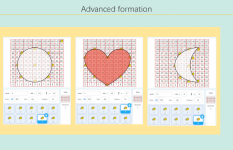Looking at several "Tello Swarming" and "Tello Formation" videos and going through some earlier discussions, I thought about how to get more out of these little gems. After some soldering and programming, this is my take on drone formations:
For those, who are interested in details:
The top-lights are an own development described here: Tello NeoPixel RGBW LED lights add-on, remote controllable, 5g
They are much lighter than the Tello Talent expansion kit and give me more options for animations.
The code controlling the drones is written in Python and controls also the lights and the synchronization of the figures with the music. As a starting point, I used this repository: GitHub - TelloSDK/Multi-Tello-Formation: A Sample Code that implements the formation function of multiple tellos (but it requires massive rework and many extensions).
My software also allows "free style" paths like Lissajous figures by implementing a closed loop using feedback from current position and a PID controller to allocate velocity to each drone in order to follow the path.
One of the big challenges was, to dose the light to the minimum for a better light show experience but to still give enough information to the VPS for position control.
Unfortunately, the position of the recording camera was too much aligned to the height of the drones, so that you loose the offset in depth. So there is still enough room for improvements...
For those, who are interested in details:
The top-lights are an own development described here: Tello NeoPixel RGBW LED lights add-on, remote controllable, 5g
They are much lighter than the Tello Talent expansion kit and give me more options for animations.
The code controlling the drones is written in Python and controls also the lights and the synchronization of the figures with the music. As a starting point, I used this repository: GitHub - TelloSDK/Multi-Tello-Formation: A Sample Code that implements the formation function of multiple tellos (but it requires massive rework and many extensions).
My software also allows "free style" paths like Lissajous figures by implementing a closed loop using feedback from current position and a PID controller to allocate velocity to each drone in order to follow the path.
One of the big challenges was, to dose the light to the minimum for a better light show experience but to still give enough information to the VPS for position control.
Unfortunately, the position of the recording camera was too much aligned to the height of the drones, so that you loose the offset in depth. So there is still enough room for improvements...
Last edited:



